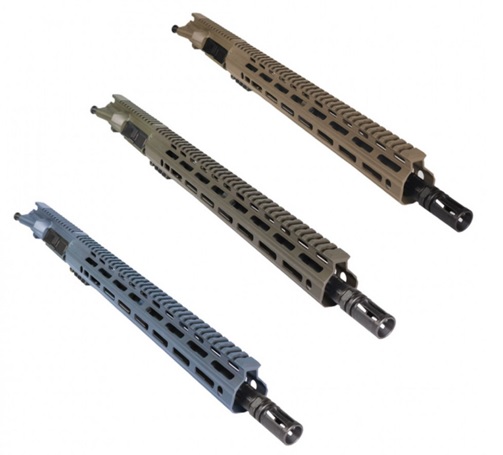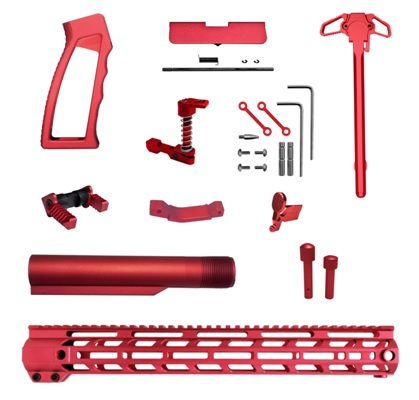The modern market offers a remarkable variety in gun part finishes which can be used to construct platforms that offer next-level permanent dry lubricity, extremely hard surface finishes, and exceptional corrosion resistance.
These are among the most popular gun finishes, how they are applied (or what the process entails), and what advantages they confer.
Read it before you jump to AR15 anodized parts; there might be something that will work better for you.
Bluing (Black Oxide)
Believe it or not, bluing is actually a close cousin of the iron oxide that we all know (and hate) as rust.
Through either a controlled electrochemical reaction or the controlled application of an oxidizing agent, a thin layer of black oxide is applied to the surface of the steel.
It is cost-effective, relatively easy to apply, and does not change the dimensions of the part.
Bluing is also one of the oldest steel treatments in the book and since it oxidizes the surface of the steel, it provides a relatively corrosion-resistant finish (the steel can’t rust twice).
Bluing can result in a matte, non-reflective finish, or be polished to create that pleasant, electric-blue look. There is also a process known as “browning” which leaves a brown look (though the process is basically the same).
While bluing does provide a decent level of protection against rust and offers a classic look, it doesn’t offer anywhere near the same level of protection against scratches and rust as the other finishes mentioned here. It also must be kept clean, dry, and oiled.
Parkerization (Phosphate)
Parkerization, which is also (less commonly) referred to as bonderization, is the process of applying a phosphate finish to a gun part (commonly, steel) by heating it in a bath of phosphoric acid, which contains zinc, manganese, copper, and nitrates and chlorates in various concentrations.
Parkerization deposits a thin layer of matte, black-gray phosphate coating on the affected component and does minimally change its dimensions.
It offers better corrosion and wear resistance than bluing and requires less maintenance, although parkerized components should also be kept clean, dry, and oiled.
Parkerization, like bluing, is cost-effective and easy to apply; parkerized parts are also readily commercially available and easy to find.
Also, parkerized components have a rougher surface finish, so moving parts (like bolt carrier groups) require more liquid lubricant to operate smoothly.
Cerakote

Cerakoting is a little bit different from the other surface finishes covered here so far because it does not change the chemistry of the steel’s surface.
Instead, cerakoting refers to the process of depositing a thin layer of ceramic coating to the surface of a part. Typically, it is a ceramic polymer, applied by air brushing which affords a uniform, smooth finish.
Ceramic coated parts are then fired in a kiln which cures and hardens the coating. As it is applied physically and not chemically, cerakoting can be applied on materials other than steel.
Cerakoted parts can have a matte finish but they typically have a smooth, glossy finish.
Cerakoting leaves an extremely hard coating that is effectively corrosion-proof and highly resistant to water as well as chemical attack.
Additionally, ceramic coatings are very hard, making them very resistant to chipping, scratches, and corrosion.
Ceramic coatings improve permanent dry lubricity, meaning less liquid lubrication is required for moving parts.
Also, ceramic coatings are available in a wide range of colors, making cerakoted parts very popular among those looking to add bright colors or unique finishes to their home builds.
Anodization

Anodizing is a process that is used to treat aluminum to improve its surface composition for hardness and corrosion resistance.
The most common type of anodization is probably a Type III anodized “hard coat,” which is applied by submerging aluminum parts in a bath of sulfuric acid and running an electric current through it.
This type of anodized hard coat substantially increases the dry lubricity of treated parts, as well as surface hardness, by as much as ten times.
Anodization does, however, change the dimensions of the treated parts, so that needs to be taken into consideration when planning.
Also, like cerakote finishes, AR15 anodized parts are available in a wide range of colors and finishes, making them popular with tinkerers looking to make customizations.
(For more information on anodized parts, please consult our previous blog in which we covered anodization at length: About AR15 Anodized Parts.)
Black Nitride
A black nitride finish, which can be applied to steel, is applied through a process known as ferritic nitrocarburizing, in which the surface of the metal reacts with carbon and nitrogen and leaves a hard (in this case), black, corrosion-resistant surface.
Nitrided finishes result from a chemical conversion of the outer surface of the metal alloy (just like bluing) which creates an extremely hard layer that is resistant to scratches, wear, water, and chemical attack.
Nitrided parts also offer a higher level of permanent dry lubricity. Because of this and the fact that nitrided parts offer exceptional resistance to corrosion and wear, this is a popular finish for moving and internal parts like barrels and bolt carrier groups.
Stainless Steel
Last but not least, we have “stainless steel” which is a loose umbrella term that is technically not a finish at all.
Stainless steel is simply a steel alloy that has had chemical elements (typically chromium) added to it, which improve corrosion resistance.
Typically, stainless steel components are silver in nature, though they can be other colors; also, since stainless is not a finish, additional finishes, like cerakote, can be applied to them.
Stainless steel alloys are popular for use in some gun parts because of their corrosion resistance, but it is important to recognize that stainless alloys can still rust.
As a result, it is still important to keep stainless components clean, dry, and protected with a thin layer of oil.
AR15 Anodized Parts (and More)
Here at MCS Gearup, we carry build kits, parts kits, and piecemeal AR15 anodized parts (and parts with other finishes, too). Take a look through our collections via the previous links and get in touch with us at Sales@MCSGearup.com if you have any questions.

